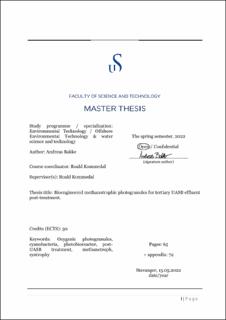| dc.description.abstract | The need for aeration when treating wastewater is the most extensive energy requirement wastewater treatment plants (WWTP) has today. This thesis investigated an attached growth process which utilise genetic features in cyanobacteria in syntrophy with other phototrophs and heterotrophs for tertiary up-flow anaerobic sludge blanket (UASB) effluent post-treatment. The oxygen produced from phototrophs was used by heterotrophs to oxidise residual COD including dissolved methane in the UASB effluent, which produce carbon dioxide that phototrophs use to produce more oxygen. Additionally, nutrient removal polishing treatment analysis was also performed. The goal of this thesis was to sustain and grow the biomass in a granular structure when seeding hydrostatically grown oxygenic photogranules in a photobioreactor used for post-UASB treatment. There was also an aim to examine if they could be enriched with methanotrophs for dissolved methane removal. To reach the goal and aim presented, a literature review is done since this is a new technology. The literature review investigates how OPGs are formed and what characteristics are important for granule formation. It also explores other studies that has tried to remove methane using the syntrophy between phototroph and methanotrophs. The OPG biomass grew in the PBR running in sequence batch operation and steadily removed the chemical oxygen demand 52,5 % ± 2.2 (± standard error), with best rate was 78,7 %. Enrichment of methanotrophs in suspension was tested in two experiments. One experiment used glass vials and the other experiment was directly in the PBR. Both proved removal of methane. The best removal efficiency from OPGs inoculated with methanotrophs was for the glass vial experiment, averages were: COD 81.5 % ± 1.1(± standard error), NH4 + 52.3 % ± 1.1, PO4 3- 49.6 % ± 2.2. Conclusion from the analysis of the experiments is that bioengineered methanotrophic photogranules can be grown in a PBR and used for tertiary UASB effluent post-treatment. There is however a potential for future research because there was relative few OPGs grown in this reactor system compared to others in the literature. From analysis of the two methanotroph experiments it is shown that a higher biomass to liquid ratio would increase the methane removal. A proposal for future research is to cultivate more OPGs using the UASB effluent in a system closed from the atmosphere. The effluent will then have more methane and CO2 in the influent of the PBR which in theory will have more carbon and nitrogen available for growth. | |
